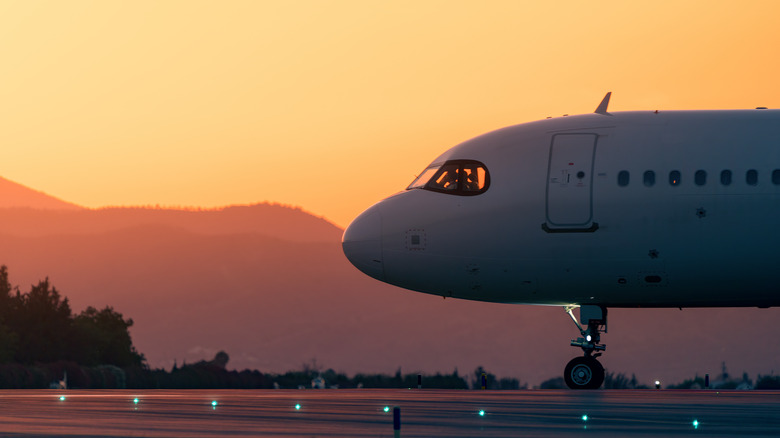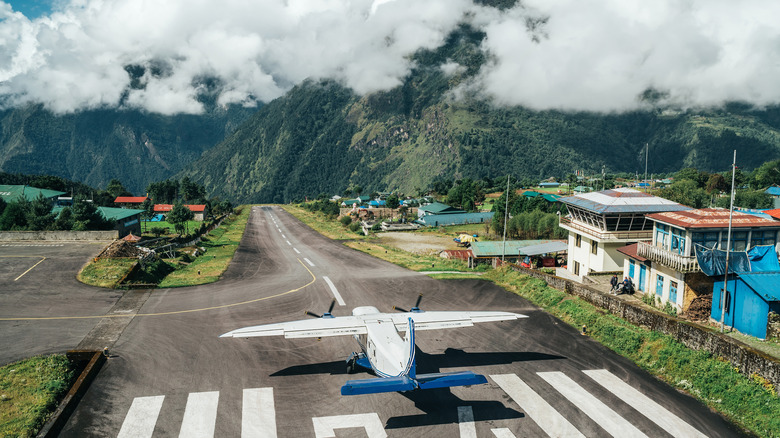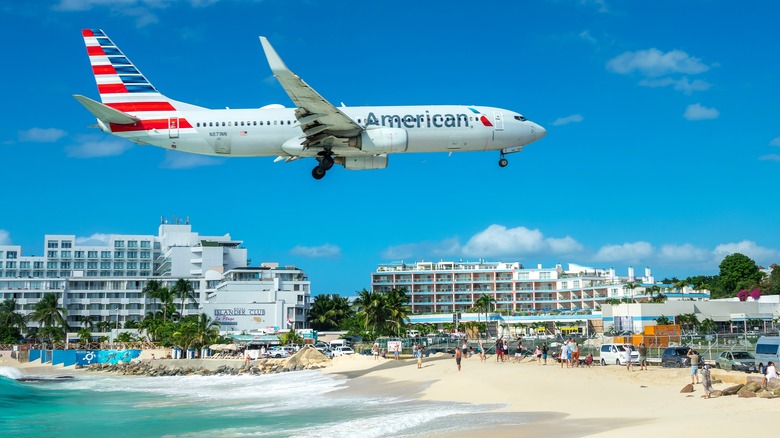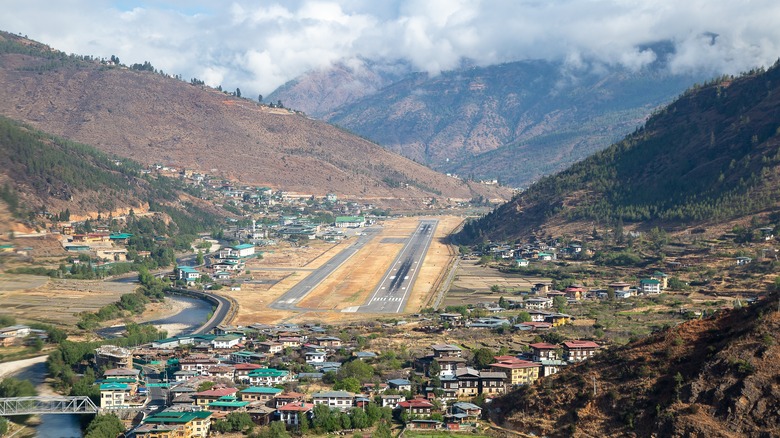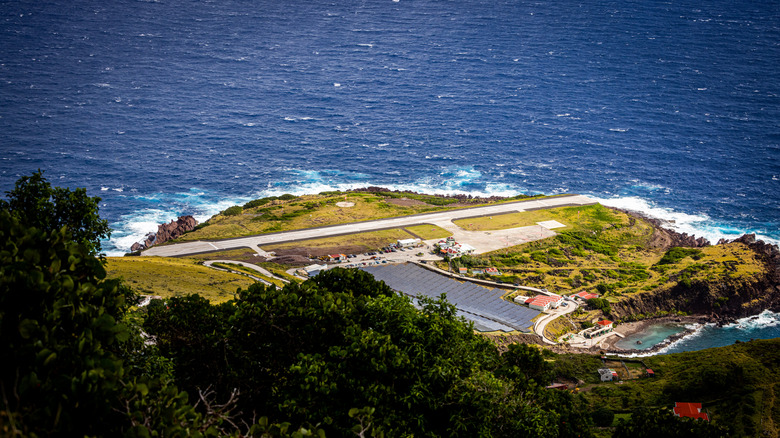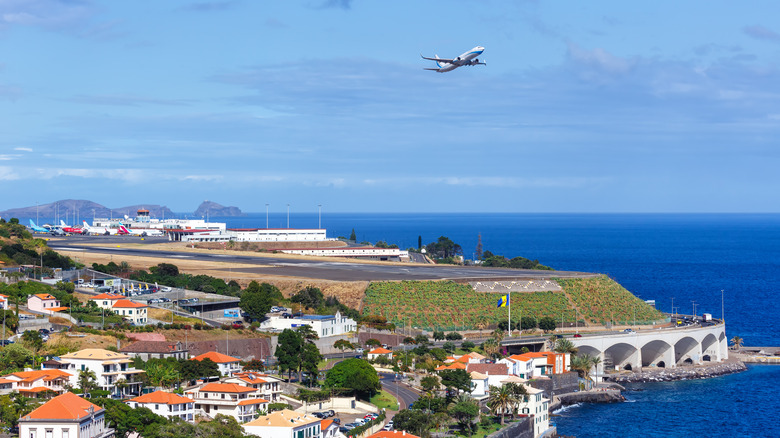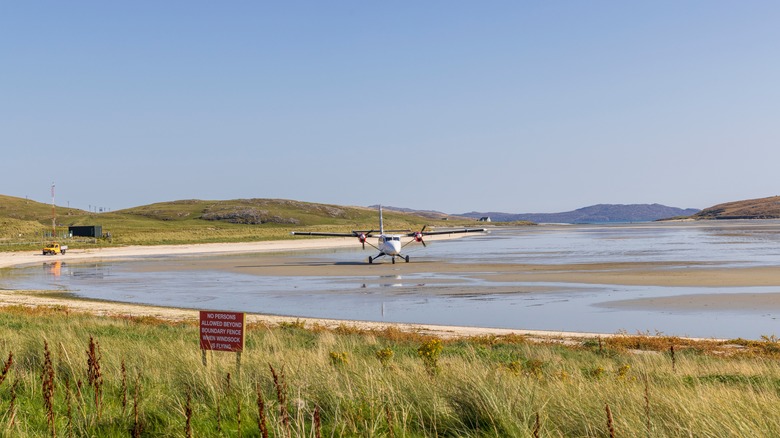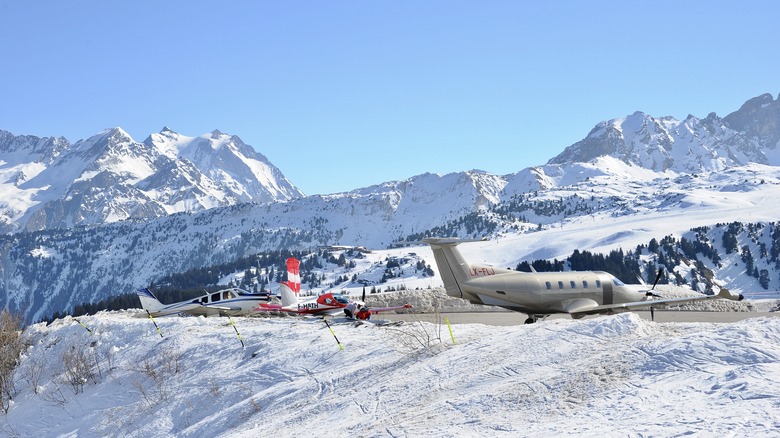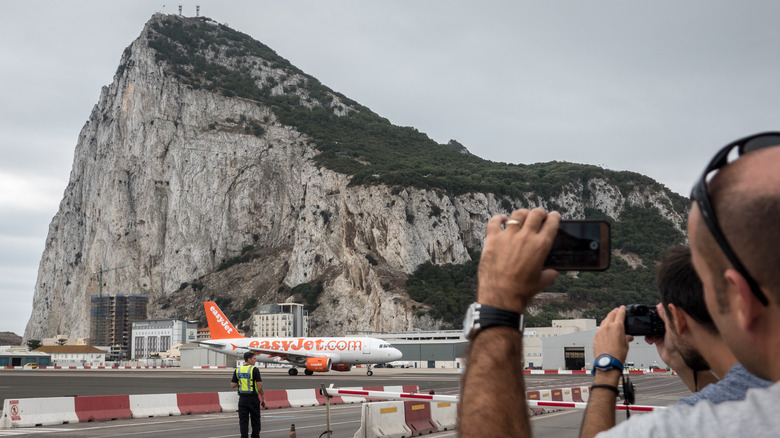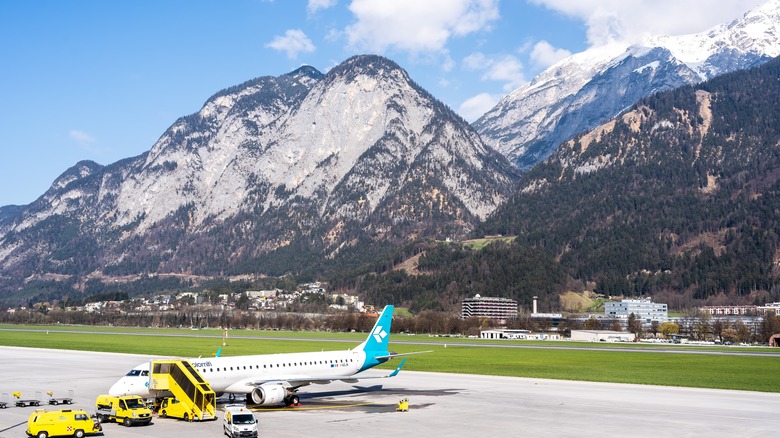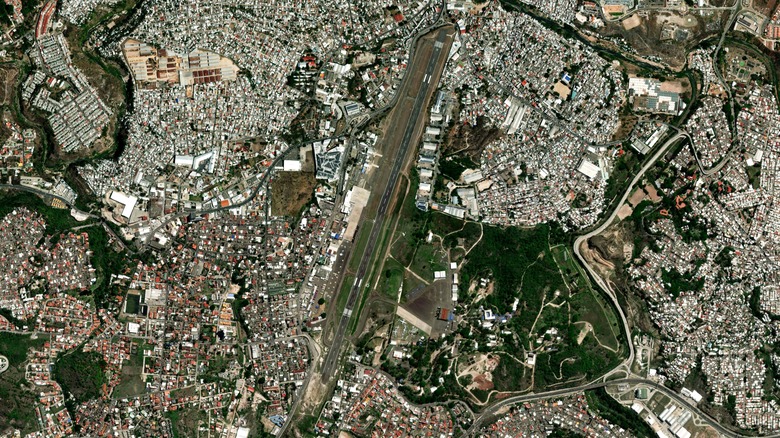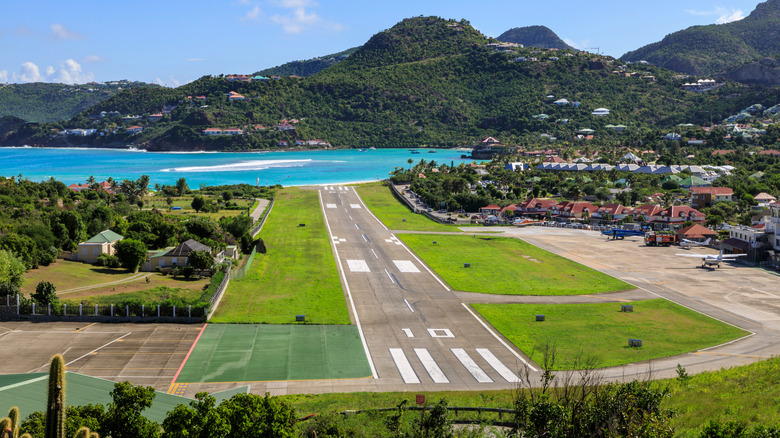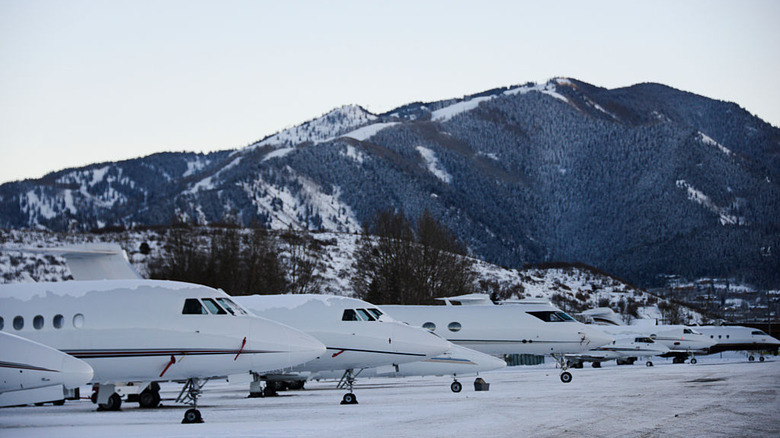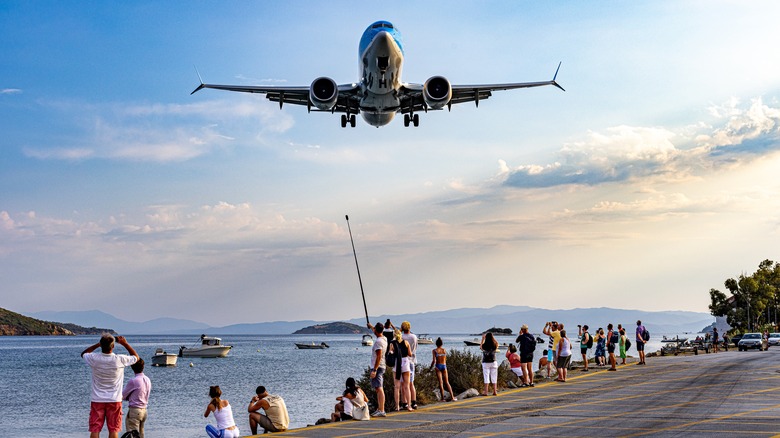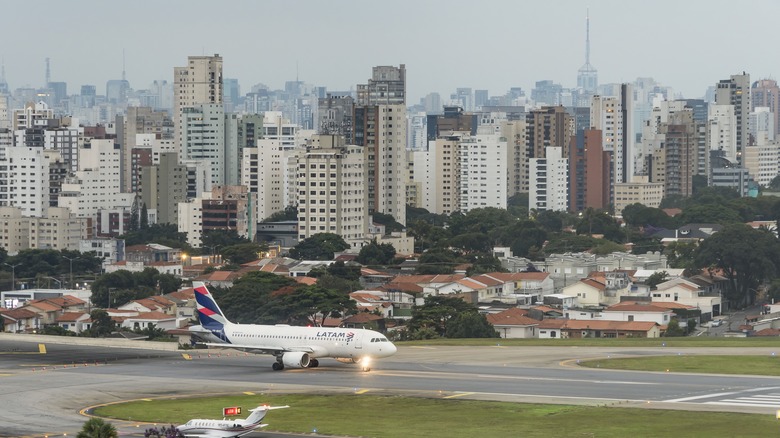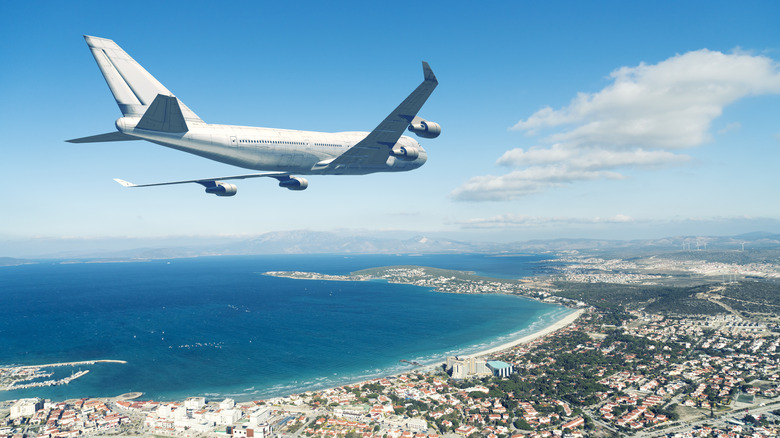Dangerous Airports Around The World You May Want To Avoid Flying Into, According To Research
They say the journey is often more thrilling than the destination. Nowhere does that somewhat cliched quote ring truer than while flying — especially if you are touching down on challenging terrain. Considering how widespread human societies are, you can find airports in some of the world's toughest locations today. Some are carved into the edge of islands, others lie sandwiched between hills and beaches, a few are situated dangerously close to high mountain peaks, while others are cramped into busy cities.
Aviators know that flying demands careful precision, even on a clear day with perfect conditions. But at certain airports, skills are pushed to such extremes that only select groups of pilots with special training are permitted to attempt them. Read on to know about some of the most dangerous airports around the world and what industry insiders, as well as regular passengers who have dared to take these extraordinary flights, have to say about their journeys.
Lukla Airport in Nepal
Nepal's incredible hiking trails are famous the world over and draw in adventurers yearly. But the journey to reach them often begins with a heart-stopping landing at the Tenzing-Hillary Airport (LUA) in Lukla, aka Lukla Airport. Tucked high in the Himalayas at about 9,500 feet, Lukla Airport has long-carried this formidable reputation for many reasons, including the short runway that gives pilots a very limited margin for error while landing and takeoff. "Most runways are quite flat and quite long, whereas this is on a hillside. It'll be close to 40 degrees in a slope," Captain Jimbo Burgess, a former Lukla pilot, told CNN.
The local topography, though surreal, doesn't help either. Daunting, mountainous slopes surround Lukla Airport and the high-altitude weather can change on a dime. The thin mountain air also means planes don't climb as easily, which is why most flights here are operational in the morning, when conditions are more reliable. Lukla Airport has a history of a few fatal crashes and authorities in Nepal have set strict qualifications for pilots flying into it.
Princess Juliana Airport in St. Maarten
St. Maarten is not your usual beach holiday destination. A day out by the turquoise waters here comes with a side of planes flying dangerously low overhead. It's all thanks to the Princess Juliana Airport (SXM), whose runway begins almost at the edge of the famous Maho Beach, making landings and takeoffs particularly dramatic. The unique approach over the ocean compels pilots to come in lower than usual, putting planes in close proximity to everyday life below.
Though the low-flying jets are common fodder for viral videos, which crowds gather to capture everyday, the whole setup carries risks that are hard to ignore. At the center of this spectacle is the airport's main strip that is just off the sandy shores — close enough for authorities to issue warnings about jet blasts that could result in death. This high caution is more than justified. In 2017, a tourist standing at the fence separating this dangerous Caribbean airport and the beach was killed after suffering injuries from a powerful jet blast.
Paro Airport in Bhutan
Not every pilot can fly into Bhutan's notoriously difficult Paro Airport (PBH). Nestled in the Himalayan valleys and surrounded by peaks rising up to 18,000 feet, this airport demands special skill training (and nerves of steel) that equips only a limited number of pilots to navigate its tricky conditions safely. "In Paro, you really need to have the local skills and local knowledge area competence," veteran pilot Captain Chimi Dorji told CNN, pointing to the "area training" pilots flying into Bhutan need to be well-versed in.
A narrow approach and a runway that becomes visible only until the final moments of touchdown are just some of the challenges at Paro. Pilots have to rely on sight, memory, and manual skill alone to navigate aircrafts in the absence of any radar or landing systems guiding them. Add to that unpredictable weather that doesn't allow flights to operate beyond noon and makes flying in the thin mountain air trickier in general. Everything considered, Paro still stands out as one of the most breathtaking airports to land at and if you're up for the ride. If you're not easily rattled, you might as well book a window seat to make the journey worth it.
Juancho E Yrausquin Airport in Saba
Juancho E. Yrausquin Airport (SAB) is known in aviation for hosting the shortest commercial runway in the world and thus, also one of the most challenging. Stretching just about 1,300 feet on the edge of the Caribbean island of Saba, it is surrounded by the vast, open, blue ocean and the strip leaves zero room for error. Because of this, larger commercial jets are banned at this airport. Only smaller planes built for short takeoffs and landings can operate here.
Beyond aircraft measurements, requirements for flying these vessels are also equally strict. Pilots need special clearance to operate in and out of Saba and the training for this conquest belongs to an elite group. As veteran pilot and fleet instructor Captain Roger Hodge told CNN: "Once a guy has been fully trained and we're satisfied, we radio into operations that another Top Gun is born."
Madeira Airport in Madeira, Portugal
Madeira is commonly known as the "Hawaii of Europe." Pristine nature, grand ocean views, and lush cliffs await on this dreamy Portuguese island. That is, if they manage to brave the difficult air journey one must take to get there. Madeira Airport, also called Funchal Airport or Cristiano Ronaldo Airport (FNC) — in honor of their native footballer — has a reputation as one of the world's most challenging airports, thanks to its dramatic setting between the mountains and Atlantic Ocean.
Pilots often need to make sharp turns and precise maneuvers to align with the runway, making landings at Madeira particularly demanding. Considering that winds can also pick up very high speeds here, pilots have to constantly adjust their approach and recalculate for each touchdown. Madeira Airport has undergone many renovations over the years to make room for larger airplanes — a notable one being its approximately 3,000 feet-long extension above water, which set a Guinness World Record as "the longest bridge-supported runway in the world" in 2011.
Barra Airport in Scotland
For several hours each day, Barra Airport (BRR) in Scotland disappears almost completely under the sea, which can make for some precarious takeoffs and landings. Barra is, in fact, the only place in the world where commercial flights land directly on a beach. Traigh Mhòr, or "Big Beach" in Gaelic, serves as the runway during low tide, when the sand is exposed and essentially becomes the runway. The airport itself is tiny and features a no-frills, basic terminal without your usual big city luxuries. That doesn't seem to bother the handful of tourists who make the journey to this remote island and are rewarded with this bucket list-worthy experience.
One Business Insider writer, who was part of a standard 15-passenger flight from Barra to Glasgow, wrote, "It was the strangest — and most peaceful — travel experience I've ever had." Magical as it may sound, pilots trained to operate at Barra Airport know the risks that come with it. The vanishing runway means that flight timings are inevitably tied to the tidal clock and changing firmness of the sandy strip.
Courchevel Airport in France
Landing and taking off from Courchevel Airport (CVF) is a high-stakes game that only the most experienced of pilots can play. At this famous ski resort nestled in the French Alps, the airport is hemmed in by grand snowy peaks, unpredictable weather, and visibility that can change in seconds. What also makes it one of the most difficult airports in the world is its short strip that is a little over 1,700 feet long and has a dangerous slope of over 18 degrees, making it one of the steepest runways anywhere in the world.
As passengers enjoy panoramic views of one of Europe's best ski destinations, pilots in the cockpit have to work with extreme precision to guarantee a safe descent at Courchevel, which has seen its unfortunate share of accidents over the years. "Once you're on the approach, at a certain point, you're committed to land because there's no possibility for a safe go-around. The terrain rises too steeply for that," pilot and aviation expert Jean-Marie Urlacher told the Aircraft Owners and Pilots Association (AOPA).
Gibraltar Airport in Gibraltar
Gibraltar Airport (GIB) was one of the only places in the world where aviation and everyday traffic intersect. This unusual design owed itself to the territory's main road, Winston Churchill Avenue, which used to cut through the airport runway up until 2023, when traffic was redirected to a new bypass tunnel, the Kingsway Tunnel. But up until then, the traffic spectacle that occurred with every takeoff and landing was often fodder for tourists taking viral videos.
The geographical makeup of the place is also demanding. With the famous Rock of Gibraltar on one side and the sea on both ends of the runway, pilots often face unpredictably strong crosswinds and sudden turbulence caused by local phenomena like the levanter that blow in through the Strait of Gibraltar. It doesn't help that at about 6,000 feet, the runway is also not particularly long. "It's such a challenging airport in fact that our Captains have to go through special training to be able to land here, and only a select few are able to operate these flights," a first officer wrote on Pilot Bible.
Innsbruck Airport in Austria
Innsbruck Airport (INN) is as beautiful as it is demanding. Think snow-capped peaks, picturesque valleys, and alpine villages — a scenery that leaves passengers awestruck but keeps pilots on edge. Tucked in the Austrian Alps, this is one of the trickiest landing environments in Europe and, for good reason, is certified as a Category C airport, which means only specially trained pilots are permitted to fly here.
Besides the narrow approach surrounded by mountains, alpine winds blow strongly here and often render the weather conditions extreme. In fact, an EasyJet pilot named Innsbruck among the airports that face the worst turbulence: "The strong winds in the area can reach speeds of up to 60 mph ... caused by strong winds funnelling [sic] through the narrow valleys between the towering mountains that surround it" (via The Independent). Thick snow and low clouds don't make the situation any easier. But despite the danger, Innsbruck remains a major draw for people who love adventure both in the skies and on skis.
Toncontin International Airport in Honduras
Flying into Toncontín Airport (TGU) is not for the faint of heart. Nestled in the mountainous terrain of Tegucigalpa in Honduras, this airport is famous (and rather notorious) among pilots for putting up a challenge with its tight, tricky approach that requires elite flying skills. It offers aviators a limited runway length of about 7,000 feet and the fact that it sits at a high elevation demands steep descents and sharp turns to line up perfectly for landing.
Toncontín's reputation is rooted in its accident-prone history, which is dotted with reports of plane crashes. Considering the risks associated with this airport, authorities inaugurated the newer Palmerola International Airport in 2021 to allow for safer comings and goings of international flights, so that "passengers can land in an airport that does not put their lives at risk," President Juan Orlando Hernandez said (via news.com.au). Though largely for domestic flights, Toncontín still remains operational today, keeping its status alive as one of the most challenging airports in the world.
Gustaf III Airport (SBH) in St. Barts
For many travelers, taking a flight to the Caribbean paradise of St. Barts is a bucket-list item on its own, even before the dreamy vacation begins. That's because the island's Gustaf III Airport, located close to a stunning beach destination, is among the most unique (and difficult) in the world. The runway — which is sloped and short, at about 2,000 feet — starts just beyond a hilltop road and ends almost directly on St. Jean Beach, making the approach challenging for even trained pilots.
Planes typically make a sharp dip over the hill and then touch down steeply within seconds. On his website, pilot James Henderson reiterated Gustaf III's status "as the third most dangerous airport in the world due to the short runway, proximity to local traffic and the steep hill on the final approach," highlighting the special training pilots have to go through to operate here. But for people blissfully lounging on the beach nearby, all this setup makes for is a front-row view of a thrilling aviation show.
St. Helena Airport in St. Helena
St. Helena, a remote island in the South Atlantic, is one of the hardest places in the world to reach and the St. Helena Airport (HLE) proves exactly why. Built on a plateau that is surrounded by sheer cliffs and seemingly endless ocean, the runway is frequently struck by crosswinds and wind shear that can make takeoffs and landings here a serious challenge. Unlike its peers on this list, St. Helena Airport is a fairly recent construction and became functional for commercial flights only in 2017, after years of delay and administrative concerns.
Besides its reputation as a dangerous place, St. Helena has also earned an unfortunate distinction as the world's most useless airport, thanks to the unpredictable weather conditions that prevent smooth operation of flights here. The runway is also just over 5,000 feet long, which limits the type of planes that can fly into this faraway British Overseas Territory. A writer for The Independent, who recorded her turbulent experience of landing here, recounted the captain's announcement that strong winds blowing at 55 mph were "quite normal conditions for St. Helena."
Aspen Airport in Colorado, United States
Aspen Airport (ASE) sits right in the middle of the Rocky Mountains, surrounded by majestic peaks and a ski scenery that looks like something out of a storybook. But pilots who fly into this part of Colorado know that touching down here is anything but a pleasant experience. The narrow valley, high altitude, and unpredictable mountain weather makes the approach into Aspen difficult for even experienced pilots, who have to consider a number of factors affecting takeoff and landing.
Aspen is located at just shy of 8,000 feet above sea level. At this altitude, the air is significantly thinner than usual, which creates a challenge when it comes to generating enough lift to take flight. Add the sudden shifts in weather that can bring in heavy fog, winds, or snow during Aspen's icy winter season to that equation. The special circumstances at Aspen allow for only certain types of planes — usually smaller jets with limited passenger capacities — and exclusively trained pilots to operate here.
Skiathos Airport in Greece
Skiathos may appeal to holidayers as the ultimate affordable alternative to Santorini. But aviation enthusiasts have another reason to visit this Greek paradise that hosts one of the most fascinating airports in the world. Skiathos Airport (JSI) is nothing less than a marvel, with its short runway that's just about 5,000 feet long and is sandwiched between swathes of the Aegean Sea. It may sound like a postcard-perfect view for the neutral observer but the experts navigating the planes that land at Skiathos know how difficult it is to make the steep descent onto the island.
The planes skim low over public life in Skiathos, with tourists lining the coastal streets to capture pictures of this unbelievable scene. Every now and then, videos of flights going in and out of Skiathos go viral on the internet, leaving some social media users awestruck and many others concerned about accidents, which are not unheard of here. More than informed about the dangers associated with these low-flying vessels, authorities in Skiathos have installed signs to alert tourists to maintain a safe distance from the jets.
Congonhas Airport in Brazil
Few airports capture the chaos of flying into a big city like São Paulo's Congonhas Airport (CGH) does. Picture this: Brazil's largest metropolis, high-rise buildings grazing the skies, busy roads buzzing with traffic, and right in the middle of it all, an airport squeezed into the urban jungle. Airplanes flying both in and out of this airport, which in itself is distinct for being one of the busiest airports in South America, appear to be dangerously close to everything happening in the city.
The risks go far beyond just appearances though. Besides the cramped layout of it all, pilots have to contend with short runways and very slippery surfaces here. In 2007, these conditions proved fatal when a flight crashed near Congonhas Airport and killed nearly 200 people (via People). A Netflix documentary on the tragedy, which is deemed to be one of the worst aviation disasters in South American history, was titled "A Tragedy Foretold: Flight 3054" — a haunting reality check about the long-known hazards of Congonhas Airport.
Methodology
To compile this list of the world's most challenging airports, we drew on a mix of aviation reports, insights from pilots and industry experts, as well as first-hand accounts from travelers who have actually touched down at these unique runways. By combining technical analysis with personal experiences, we managed to capture the challenges that give these airports fearsome reputations from short runways to tricky approaches, extreme geography, and unpredictable weather. We also considered the human side of these air journeys that keep both aviators and passengers on the edge of their seats.
Voices in reputable sources like Business Insider and the Independent, and even personal blogs written by pilots who have been to these airports, gave us access to verified data and detailed anecdotes that helped us understand the high-stakes setups at these thrilling airports. We also analyzed videos of aircraft landings and takeoffs at these airports, which often go viral on the internet, to see these surreal maneuvers in action.
